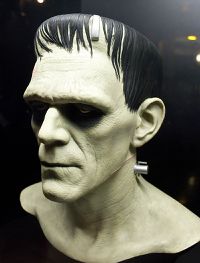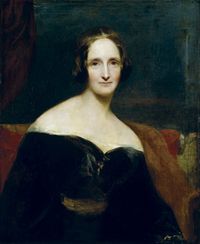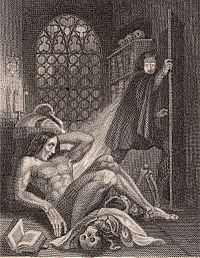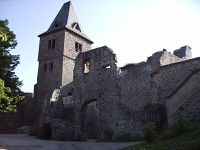What is the history behind Frankenstein
Frankenstein is perhaps one of the best-known monsters in all of literary history and popular culture. The monster and the tale of his creation has been portrayed countless times in movies, comics, and even cartoons. The story of Victor Frankenstein and his creation is concerned with some profound themes, such as the ethics of science and the nature of humanity.
The tale that involves reviving the dead and monsters is often seen as fantastical. Mary Shelly, the author of the original story, was inspired by historical personages and actual scientific experiments. While there was never a monster, much of the story was based on real-life events and historic practices.
Mary Shelly- brilliance and tragedy
The creator of one of the greatest horror stories of all time was an English lady. Mary Godwin (1797-1851), was the daughter of the great feminist author Mary Wollenscroft and the political philosopher William Goodwin. When she was 16 she began an affair with the English poet Percy Bysshe Shelly. Her father disapproved of the affair and the young lovers eloped to France.
While visiting Lord Byron near Lake Geneva, Mary, conceived of the idea for her most famous creation. The idea for the story came to her as she and some friends were having a competition, as to who could write the scariest ghost story. She won the competition and began to turn her idea into, first a short story and then a novel.
Mary developed the idea when she was only 18 years old. Her future husband, Shelley, is believed to have given her advice on the plot and the novel’s development. The novel, Frankenstein, the Modern Prometheus was published in 1818 to great acclaim. Mary married Shelly in 1816. After several years of marriage, her husband drowned, which left her devastated.
She lived her remaining years, caring for her son and continued to write novels. Her later works were not well received at the time, but in recent decades there has been a reappraisal of her later novels such as The Last Man. Mary continued to mourn her husband until her death and never remarried.
The Story
The novel begins with a captain exploring the Arctic comes across Victor Frankenstein, a Swiss scientist, and Baron. He tells the captain a remarkable story. Born in Geneva, in 1793, and raised in Castle Frankenstein, during his youth he falls in love with his stepsister Elizabeth. Victor and Elizbeth become secretly engaged before he moves to Ingolstadt to study. Here he becomes fascinated with science and befriends another student Henry Clerval. Victor becomes the protegee of a brilliant scientist, Prof. Waldman, who believes that it is possible to create a living being.
However, Waldman is reluctant to experiment on the dead because he fears unintended consequences. However, after he dies Victor steals his notes and begin to experiment on the dead in his family Castle. He attempts to create a living being out of parts of dead people. Victor believes that he is creating a superior type of being. The young Baron manages to create a living being but to his horror, it is a monster. In the novel it is known as the Creature. The monster is typically known by the name of his creator Frankenstein, but this is not the case in the 1818 novel. Victor is appalled by what he has done and finally admits that he made a terrible mistake. He abandons the Creature and expects him to die. He manages to survive and learns to speak and even to read and write.
The being created by Victor Frankenstein wants to be part of society, but he is rejected and experiences profound loneliness and becomes increasingly embittered. He blames his creator for his plight. The Creature finds Frankenstein and demands that he makes him a female companion. The Baron refuses and the Creature swears to kill all those whom Victor loves if he does not make him a partner. Victor fearful for the safety of his loved ones reluctantly agrees and the two travel through Europe looking for body parts out of which to create a companion for the Creature.
Eventually, Baron Frankenstein has second thoughts and once more abandons his creation. The monster, in revenge first kills his best friend and then Elizabeth. Victor vows revenge and follows the Creature, who flees to the Arctic. During the pursuit, the Baron, falls sick and dies. The monster is distraught at the death of his creator and is last seen on an ice flow drifting out to sea, presumably facing certain death.[1]
Literary influences
Like many writers, Shelley was moved to create a character or story by her literary peers. One of the possible literary sources of Shelley’s work was likely to have been François-Félix Nogaret (1740-1831). He wrote a novel with a central character with a name similar to Frankenstein who is also a scientist. He creates an automaton or a robot. Nogret work is an allegory of the French Revolution and its attempt to transform humanity and human nature.[2]
Other literary sources for the work of Shelley was probably the myth of Prometheus in the Latin epic Metamorphoses by Ovid. Then many see similarities between the Creature in Shelley’s novel and the character of Satan in John Milton’s epic poem, Paradise Lost. Both seek to question their creator as to the purpose of their existence and eventually come to challenge their makers.[3]
The occult

The author was writing during the Romantic period which was fascinated by the occult and magic. Supernatural and occult stories from German were especially popular.[4] Mary Shelly was very familiar with stories about Medieval alchemists.
Alchemy was considered to be a branch of natural philosophy, the forerunner of modern science before the modern era. Alchemists were a combination of magicians and scientists. They were often believed to be engaged not in science, which was not well-defined in the Middle Ages, but in Black Magic. There were undoubtedly some aspects of alchemy that were related to myth, magic and the spiritual world. They carried out experiments that attempted to turn base metals into gold. Some alchemists tried to find magic elixirs that made people eternally youthful or even immortal.[5]
Many of them were charlatans and impostors. Yet some were also engaged in empirical experiments and they helped to develop the basics of modern laboratory practices. One famous alchemist who was also a pioneer in medicine was the German, known as Paracelsus. Alchemists were often regarded with suspicion by the Church and society at large. However, they were often protected by powerful lords, who believed that they had special powers and knowledge.[6] Figures, who practiced the occult, were possibly the model for the character of Victor Frankenstein. Indeed, in the novel, the young Baron, in his youth read some of the major alchemists’ treatises such as Albertus Magnus.
Giovanni Aldini
Related Articles
- Why was Britain able to establish an Empire in India
- How Historically Accurate is Season 4 of The Last Kingdom
- Why did the Allies struggle to resolve any meaningful issues at the Potsdam Conference in 1945
- What was the Venezuela Boundary Dispute
- How did the Sepoy Rebellion (Indian Mutiny) change India
- How Historically Accurate Is Victoria and Abdul
- How Historically Accurate Is The King
- Was the story of Jekyll and Hyde based on real-life characters
- How did the Reagan Administration react to the Falklands War
Mary Shelley was a very learned woman and she was very aware of the intellectual trends of the time. Following the Enlightenment, there were a remarkable number of scientific discoveries in areas as diverse as chemistry and biology. The study of electricity was something that was emerging at this time. It fascinated many, who believed that it could transform not only society but actually humanity. One of the most remarkable claims for electricity was that it could reanimate the dead.
In the second edition of her most famous novel, Shelley states on the night that she conceived of the story of Victor Frankenstein and his Creature she was thinking about the work of Giovanni Aldini (1762 – 1834). He was a scientist and was the nephew of Luigi Galvani (1737-1798). Galvani was one of the pioneers in bioelectricity and he was the first to demonstrate that the muscles of dead animals could be briefly re-animated by electricity, a method that was known as the ‘galvanic process’. Galvani was one of the first to show how electricity was important as signaling in the muscles, nerves, and brains. Aldini continued his uncle's works and even extended it to other areas. Aldini was also a brilliant anatomist and was concerned about how to extend human life. Much of his work was scientifically significant.
However, Aldini was also a showman and conducted many public displays based on his uncle’s work. Most famously in 1803, he used electricity to stimulate the limbs of an executed criminal in London. Aldini' was able used electro-stimulation methods to make the dead criminal’s hand move and even open his eye-lids. The executed man was George Foster who had drowned his wife and child in a canal. Aldini staged his displays when Shelley was still a small child, but she was aware of the Italian’s work and it haunted her imagination. It appears that Aldini was a model for Victor Frankenstein and his electro-stimulation techniques inspired Shelley to develop a story of a scientist who reanimates the dead.[7]
Johann Conrad Dippel
Many academics believe that Johann Conrad Dippel (1673-1734), who was a German theologian, mystic, scientists, fraud, and alchemist was the chief inspiration for Victor Frankenstein and his experiment. He was born in Castle Frankenstein, this is a castle that overlooks the city of Darmstadt, in Germany. Shelley sets some of her chapters in her novel in this old fortress and adopted its name for her main character, Victor Frankenstein. Dippel was a child prodigy and had mastered many subjects at a young age. He achieved fame because of his theological writings, which claimed that the Second Coming of Christ was imminent. Dipple was a very controversial figure and his theories were widely condemned by mainstream theologians. At some time, he became interested in alchemy and he developed an elixir that he claimed could help people to live to a great age. This became known as ‘Dipple’s Oil’ and became popular.
The German tried to swap the recipe for the elixir for Castle Frankenstein, but this offer was wisely refused, by the owners. There are many stories told about Dipple. Some claim that he experimented with explosives and during one, he accidentally blew up a tower in Castle Frankenstein. It is known that Dipple conducted experiments on dead bodies and animals. This was illegal and many people believed that such experiments meant that Dipple was engaged in black magic. There are claims that the local people eventually drove him from Castle Frankenstein. Many others saw him as a fraud. He continued to work as an alchemist and claimed to have found an elixir that could exorcize demons.
Dipple continued to experiment with elixirs of life and engaged in anatomy. Many people believed that he had sold his soul to the Devil. Dipple died of a stroke, but some believed that he was poisoned. In the year before his death, he had published a claim that he would live to over one hundred because of a recent discovery. Mary Shelley would have known about this remarkable character through her stepmother, who was a translator of German literature. There are some similarities between Victor Frankenstein and Dippel. Both were engaged in illegal experiments and they both sought to test the boundaries between life and death.
Conclusion
The story of Victor Frankenstein and his Creature have captivated the imagination of the public for two centuries. The novel is a work of fiction, but it was undoubtedly based on historical events and people. Shelley was inspired in part by the experiments by alchemists. Her novel is very similar to many of the tales of medieval occultists. Shelley was writing in a period when scientists were making important discoveries’ and this may also have influenced the wife of the great English poet.
There were also historical persons who may have been models for Victor Frankenstein. The Italian Aldini who conducted electrical experiments on dead bodies was a possible influence on the work of Shelley. There are many similarities between Victor Frankenstein and Dippel. It is likely that the remarkable work and life of the German was a model for Victor Frankenstein.
Further Reading
Carlson, Julie A. England's First Family of Writers: Mary Wollstonecraft, William Godwin, Mary Shelley. (JHU Press, 2007.)
Fisch, Audrey, Anne K. Mellor, and Esther H. Schor, eds. The Other Mary Shelley: Beyond Frankenstein. (Oxford University Press, 1993.)
References
- Jump up ↑ Shelley, Mary. Frankenstein (Peterborough, Broadview Press, 2012)
- Jump up ↑ Baldick, Chris. In Frankenstein’s shadow: myth, monstrosity, and nineteenth-century writing (Oxford, OUP, 1990), p 113
- Jump up ↑ Baldick, p. 145
- Jump up ↑ Conger, Syndy McMillen. "A German Ancestor for Mary Shelley's Monster: Kahlert, Schiller, and the Buried Treasure of" Northanger Abbey"." Philological Quarterly 59, no. 2 (1980), p. 216
- Jump up ↑ Buchen, Irving H. "Frankenstein and the Alchemy of Creation and Evolution." The Wordsworth Circle 8, no. 2 (1977): 103-112
- Jump up ↑ Buchen, p. 111
- Jump up ↑ Schor, Esther, ed. The Cambridge Companion to Mary Shelley (Cambridge, Cambridge University Press, 2003), p 115



